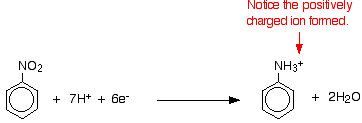Preparation of Phenylamine Compounds
- Page ID
- 3993
This page looks in outline at the preparation of phenylamine (also known as aniline or aminobenzene) starting from benzene. The benzene is first converted to nitrobenzene which is in turn reduced to phenylamine.
Benzene to nitrobenzene
Benzene is nitrated by replacing one of the hydrogen atoms on the benzene ring by a nitro group, NO2. The benzene is treated with a mixture of concentrated nitric acid and concentrated sulphuric acid at a temperature not exceeding 50°C. The mixture is held at this temperature for about half an hour. Yellow oily nitrobenzene is formed.
![]()

You could write this in a more condensed form as:
\[ C_6H_6 + HNO_3 \rightarrow C_6H_5NO_2 + H_2O\]
The concentrated sulfuric acid is acting as a catalyst and so isn't written into the equations. The temperature is kept relatively low to prevent more than one nitro group being substituted onto the ring.
Nitrobenzene to phenylamine
The conversion is done in two main stages:
Stage 1: conversion of nitrobenzene into phenylammonium ions
Nitrobenzene is reduced to phenylammonium ions using a mixture of tin and concentrated hydrochloric acid. The mixture is heated under reflux in a boiling water bath for about half an hour. Under the acidic conditions, rather than getting phenylamine directly, you instead get phenylammonium ions formed. The lone pair on the nitrogen in the phenylamine picks up a hydrogen ion from the acid.
The electron-half-equation for this reaction is:
![]()

The nitrobenzene has been reduced by gaining electrons in the presence of the acid. The electrons come from the tin, which forms both tin(II) and tin(IV) ions.
\[ Sn \rightarrow Sn^{2+} + 2e^-\]
\[ Sn^{2+} \rightarrow Sn^{4+} + 2e^-\]
Stage 2: conversion of the phenylammonium ions into phenylamine
All you need to do is to remove the hydrogen ion from the -NH3+ group. Sodium hydroxide solution is added to the product of the first stage of the reaction.
![]()

The phenylamine is formed together with a complicated mixture of tin compounds from reactions between the sodium hydroxide solution and the complex tin ions formed during the first stage. The phenylamine is finally separated from this mixture. The separation is long, tedious and potentially dangerous - involving steam distillation, solvent extraction and a final distillation.
Summary

You are almost bound to need the mechanism for the nitration reaction as well.
Contributors
Jim Clark (Chemguide.co.uk)


